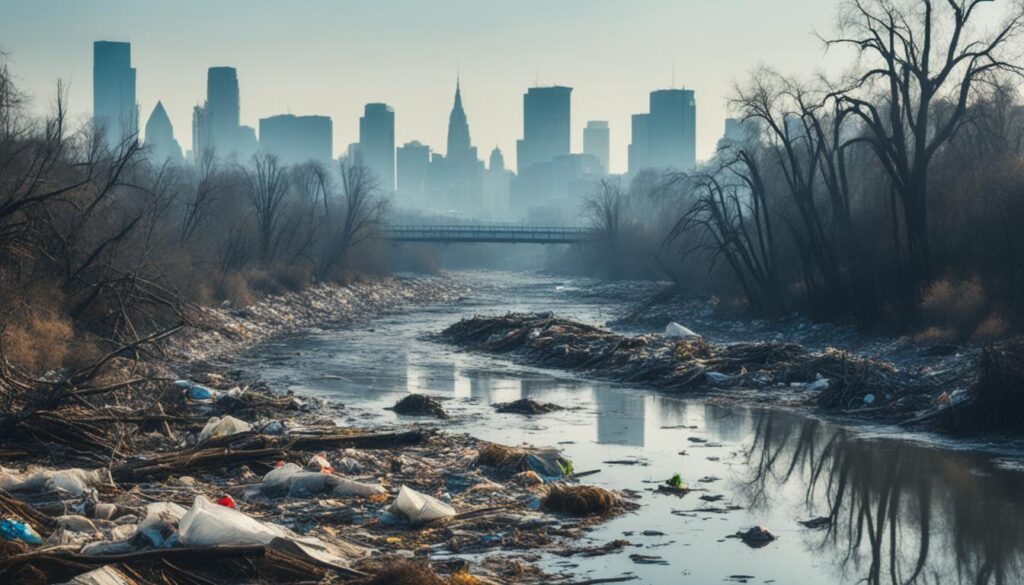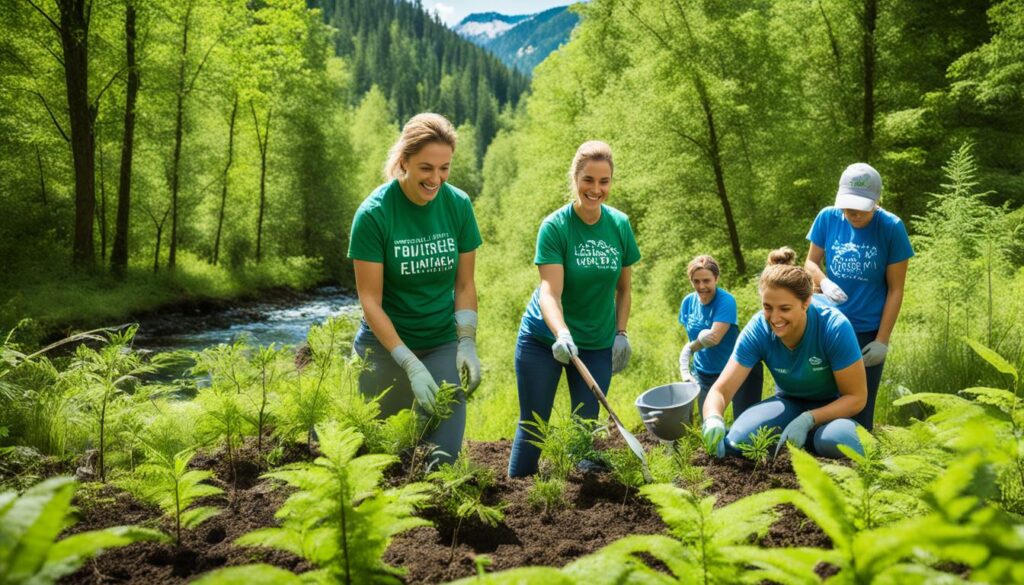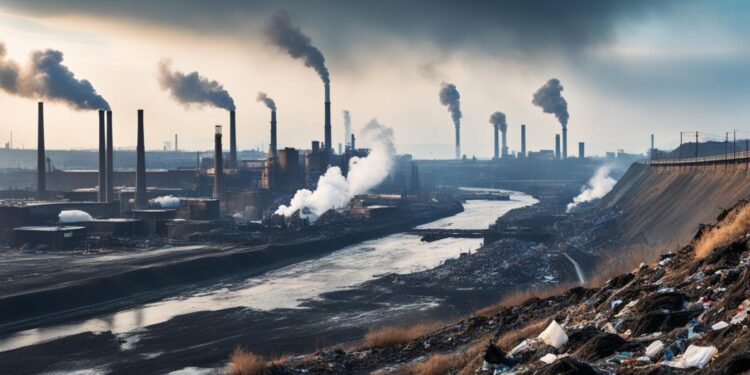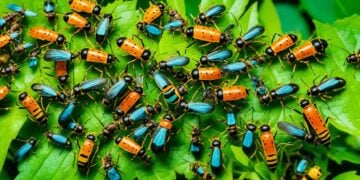Humanity’s impact on Earth has grown a lot over the years. It has changed the natural world in big ways, some of which are worrying. This article will look at how our actions affect nature and why we need to act sustainably to protect the natural world for the future.
As more people and industries have grown, so has our ecological footprint. This has often harmed the natural environment. Things like deforestation, losing habitats, and harming ecosystems have led to fewer species. Pollution has also damaged the environment, polluting air, water, and soil and upsetting the balance of life on Earth.
These actions have big effects, like breaking natural cycles and making climate change worse. As the planet warms up, we see how important our natural environment is for our health and the future. We all need to work together to focus on being sustainable and taking care of the environment.
Exploring Nature’s Delicate Balance
Our world is filled with a complex web of relationships. Every living thing, from tiny microorganisms to large species, is crucial for keeping the balance. This balance is key to our planet’s biodiversity and stability.
Nature’s balance is truly amazing. Every creature, from tall trees to small insects, is connected to others. This connection helps share resources, cycle energy, and keep the environment healthy.
But, human actions threaten this balance. We’re taking too much from nature, cutting down forests, and changing landscapes. If we don’t protect nature, we could harm the life that depends on it.
We need to understand how everything in nature is connected. By doing so, we can work to protect our planet. This way, future generations can also enjoy the beauty and balance of our world.
Human Activities Shaping Natural Landscapes
Urban growth is changing the natural world a lot. Cities grow to house more people, taking over important habitats. This leads to habitat destruction, which harms ecosystems and reduces biodiversity. Many species are losing their homes and struggling to survive.
Urbanization and Habitat Loss
Urban growth is harming nature. Cities and their buildings, roads, and factories take over natural areas. This pushes out many animals, causing them to lose their homes. This leads to more conflicts between humans and wildlife, upsetting the balance in nature.
Deforestation and Biodiversity Decline
Deforestation is another big problem. It happens for farming, logging, and building. Forests, full of plants and animals, are being cut down. This destroys homes and disrupts food chains and nature’s balance. Losing species harms the health of ecosystems.
We need to find a way to use land wisely and protect nature. Balancing human needs with nature’s protection is key. This way, we can live with nature, not against it.
Pollution: A Looming Threat to Nature
Environmental pollution is a big problem that threatens nature’s balance. Air pollution is especially worrying, affecting ecosystems and human health.
Air Pollution and Its Consequences
Air pollution comes from many sources like factories, cars, farms, and homes. Pollutants like dust, nitrogen oxides, and carbon monoxides harm nature. They can kill plants, break the food chain, and make air unhealthy.
Air pollution also harms people’s health. It can cause breathing problems, heart issues, and even cancer. Kids and the elderly are most at risk, facing long-term health problems.
To fight environmental pollution, we need many solutions. We must have stricter rules, new technology, and work together to reduce pollution. By improving air quality, we can protect nature and ensure a better future for everyone.

Climate Change: Nature’s Greatest Challenge
The world is facing a big threat from climate change. Human actions release gases that change our planet’s balance. This is making big changes in nature, like rising temperatures and changing weather patterns.
Climate change is causing big problems for nature. Species are struggling to adapt as temperatures go up and weather gets wild. This is destroying homes for animals and plants. It also hurts people who depend on nature for their way of life.
We must act fast about climate change. The science shows it’s real and it’s happening now. We see things like melting ice, rising seas, and more severe weather. If we don’t cut down on pollution, nature could be in big trouble.
We need everyone to help save nature from climate change. Governments, companies, and people must work together. We should use clean energy, live more sustainably, and protect nature’s homes. By taking action, we can keep nature beautiful and strong for the future.
Sustainable Living: Preserving Nature’s Wonders
We are working hard to protect our planet’s ecosystems. Sustainable living is key to keeping nature’s diversity. By living sustainably, we can lessen our impact on the environment and protect the natural beauty that inspires us.
Renewable Energy: Harnessing Nature’s Power
Renewable energy is central to sustainable living. Sources like solar, wind, and hydroelectric power use the sun, wind, and water’s energy. These alternatives to fossil fuels are clean and endless. Switching to them cuts down our carbon emissions and lessens our environmental harm.
Sustainable living also means taking care of the environment in many ways. This includes managing waste well, saving water, and choosing eco-friendly products. By making these choices every day, we help protect nature, save endangered species, and keep our ecosystems healthy for the future.
Living sustainably is a team effort. It needs work from communities, leaders, and companies. Together, we can push for sustainable actions and teach the importance of caring for the environment. By living sustainably, we make sure future generations can still enjoy nature’s beauty and its riches.
Nature’s Resilience and Recovery
The natural world shows an amazing ability to bounce back from human harm. Around the world, we see places that were once damaged now thriving again. This shows how strong and adaptable nature’s systems are.
Take Yellowstone National Park after the big wildfires in the 1980s and 1990s. It looked like nothing could survive, but nature proved us wrong. The park’s plants and animals came back, making the land vibrant and full of life. This shows how nature can heal itself.

When mining stopped in some areas, nature showed it could recover. With less human harm and efforts to fix the damage, these places got better. Native plants and animals came back, making the ecosystem healthy again.
But it’s not just land that can recover. The oceans can too, if we let them. When we stopped overfishing and cleaned up pollution, marine life started to flourish. Coral reefs and sea creatures came back, making the ocean healthy again.
These stories of nature’s comeback remind us why we must protect our planet. By helping nature heal itself, we can live in better harmony with the earth.
Conservation Efforts: Protecting Nature
Human actions are harming the natural world more and more. That’s why conservation efforts are key to fighting environmental damage. These efforts help keep ecosystems balanced and protect the wide variety of life on Earth.
National Parks and Wildlife Sanctuaries
National parks and wildlife sanctuaries are vital for conservation. They protect many plants and animals from human harm. Places like Yellowstone, Yosemite, and the Everglades show the beauty of nature and teach us about protecting it.
Wildlife sanctuaries are also important for saving endangered species and their homes. They are run by governments and groups focused on conservation. Sanctuaries keep certain animals safe, like elephants and leopards, by limiting human contact and managing the land well.
These protected areas need help from many people to keep going. It takes work from leaders, scientists, and the public to keep them safe for the future. Protecting nature, national parks, and wildlife is all connected. We need a complete plan to solve the big problems facing our planet.
Reconnecting with Nature
In today’s fast-paced world, it’s easy to forget about the nature around us. But reconnecting with nature has many benefits. By taking a break from daily life and enjoying the outdoors, we gain a deeper understanding of the environment and ourselves.
Outdoor activities like hiking, camping, or visiting a park help us bond with nature. These activities are great for staying active and engaging our senses. We get to enjoy the fresh air, feel the sun, and hear nature’s sounds. This helps us feel calm and refreshed.
Being in nature also has long-term benefits for our well-being. Studies show it lowers stress, improves mood, and helps our brains work better. Nature makes us feel connected and gives us a sense of purpose. This strengthens our bond with the environment and our role in protecting it.
Whether it’s a walk in the park, helping with a conservation project, or a camping trip, reconnecting with nature is key. It boosts our mental, physical, and environmental health. By making time for nature, we improve our lives and help protect the world around us.
Nature’s Impact on Human Well-being
Studies show that nature greatly improves human health and happiness. Being in natural places like parks, forests, or beaches lowers stress and boosts mental and physical health. Environmental psychologists have found that nature helps with depression, anxiety, and other mental health issues.
Nature also helps communities in many ways. It encourages people to be more active, which is good for health. Protecting nature also helps local economies by drawing in eco-tourists and supporting green industries like ecotourism and renewable energy.
Living an eco-friendly life helps protect our planet’s balance. This is good for the environment and ensures future generations can enjoy nature’s benefits. It also helps us all, offering many physical, mental, and social benefits.







